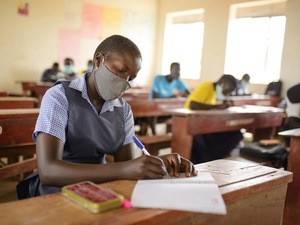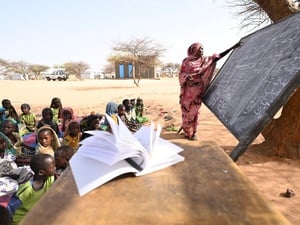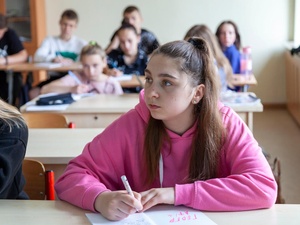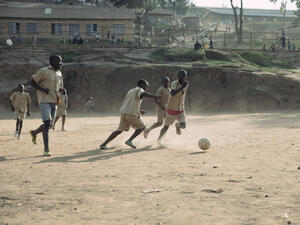Travelling exhibition on refugee children opens in Las Vegas
Travelling exhibition on refugee children opens in Las Vegas
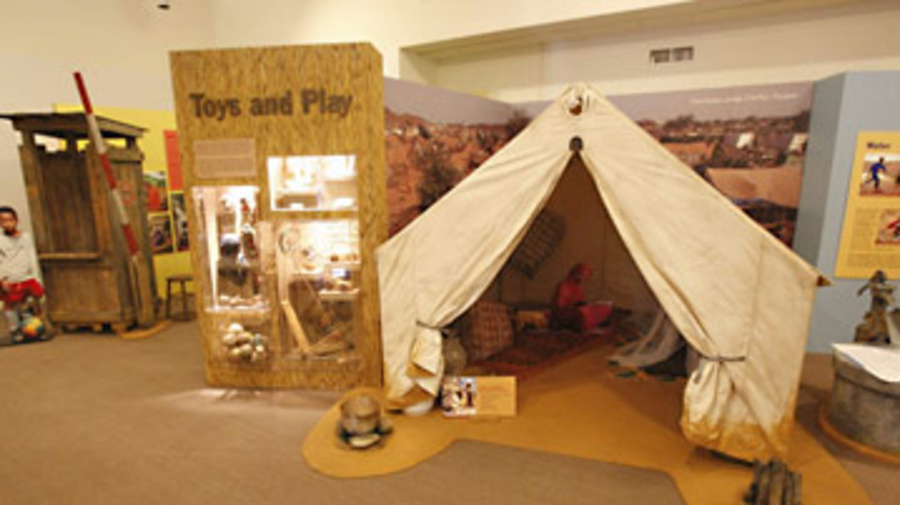
A section of the interactive exhibition, "Torn from Home: My Life as a Refugee", at the Lied Discovery Children's Museum in Las Vegas.
LAS VEGAS, United States, June 16 (UNHCR) - A new travelling exhibition offering schoolchildren and other visitors a hands-on learning experience into the lives of young refugees and their families has opened at the Lied Discovery Children's Museum in Las Vegas.
The interactive exhibit, "Torn from Home: My Life as a Refugee," recreates refugee camp settings and takes young visitors through exhibit areas where they learn about the shelter, food, medical care, schooling, and play activities of children in refugee camps. It was developed with the help of leading international aid organizations, including the UN refugee agency, the World Food Programme and Save the Children.
Saturday's opening involved refugee children from Iraq, the Democratic Republic of the Congo (DRC) and Afghanistan. The refugee children, whose ages ranged from six to 16, engaged in peer-to-peer learning activities with young visitors in the exhibit areas and shared their extraordinary life stories.
"I'm so glad to be here to teach American kids about what it is like to live in a refugee camp," said Espoire*, a 13-year-old Congolese refugee whose family was forcibly displaced twice due to mass atrocities committed in their region of DRC.
Michel Gabaudan, UNHCR's regional representative, told a crowd of some 350 museum visitors that the exhibit would help to increase awareness about "what it means to be a refugee" and the plight of millions of refugee children around the globe.
Gabaudan spoke about UNHCR's role in assisting refugees, protecting their rights, and helping them to overcome struggles and look to the future. "We find solutions for refugees, so they don't stay in refugee camps too long," he said, adding: "We strive to keep providing refugees with hope."
Upon entering the replica camp, visitors will be registered and processed as a refugee. Walking through exhibit areas, they gain a first-hand look at the daily challenges faced by refugee children and their families, and also experience the personal triumphs of rebuilding their lives in a new land.
A display case features toys created from basic items by displaced children in Uganda. Roberta Russo, UNHCR spokesperson in Uganda, coordinated the children's toymaking activities for the exhibit. Museum curator Elaine Bole, who brought the toys back from Uganda, said they highlighted the creativity and imagination of refugee children.
"The toys have been a big hit with the children visiting the museum because they see that refugee children play familiar recreational games," said Bole. "It makes them realize that they have a lot in common with refugee children." And visitors attending the exhibit opening had an opportunity to make their own footballs out of plastic bags and strings.
Bole, who worked with exhibit developer Stacey Mann on the education component, said children would be immersed into refugee life by touching items found in camps; hearing the voices and life stories of refugee children; and engaging in interactive age-appropriate educational activities on human rights.
As young visitors exit the exhibit, they learn what happens to refugees after they leave the camp, including repatriation, resettlement and other durable solutions. Two interactive video kiosks will encourage children to share their reflections about the exhibit. A resource centre allows visitors to access information on aid organizations working with displaced populations.
"I hope everyone visiting this exhibit will leave the museum wanting to create a more secure and peaceful world," said philanthropist Pam Omidyar, who helped conceive the exhibit with curator Bole and provided core funding.
Omidyar encouraged visitors to learn more about protecting the rights of refugees. "We can make sure they are well taken care of and given opportunities so they can one day return home and rebuild their countries."
The exhibit will be housed at the Lied Discovery Children's Museum until the end of the year. It will then travel to other children's museums and venues across the United States over the next three to five years.
* Name changed for protection reasons




